#Science tutors London
Text
Mindcarft academy Private Tutors in Leeds Available..!
Mindcraft academy has an experienced private tutor in Leeds can significantly enhance a student's learning experience in several ways:
1. **Customized Learning Plan**: A tutor assesses the student's strengths, weaknesses, and learning style to create a personalized study plan that targets areas needing improvement while reinforcing strengths.
2. **Individualized Attention**: Unlike classroom settings, where teachers have to divide attention among many students, a private tutor focuses solely on the student. This ensures that all questions are answered, concepts are thoroughly understood, and the pace of learning is optimal for the student.
3. **Clarification of Doubts**: Students often hesitate to ask questions in a large classroom environment due to fear of embarrassment or time constraints. With a tutor, there's a safe space to ask any question without judgment, ensuring all doubts are clarified promptly.
4. **Motivation and Confidence**: Tutors can provide encouragement and positive reinforcement, boosting the student's confidence and motivation. This is especially important in subjects where the student might struggle or feel discouraged.
5. **Expertise and Guidance**: A tutor typically has expertise in their subject area and knows the curriculum well. They can provide insights, tips, and strategies for tackling difficult concepts and exams effectively.
6. **Flexibility and Convenience**: Private tutoring sessions can be scheduled at times convenient for both the student and the tutor, allowing for flexibility in learning. This can be particularly helpful for students with busy schedules or specific learning needs.
7. **Exam Preparation**: Tutors can assist with exam preparation by teaching study skills, providing practice questions, and offering guidance on exam techniques. This helps students perform better under exam conditions and reduces anxiety.
8. **Continuous Assessment**: Tutors can regularly assess the student's progress and adjust the learning plan accordingly. This ongoing feedback ensures that the student stays on track and maximizes their learning potential.
Overall, an experienced private tutor in Leeds serves as a mentor, guide, and coach, supporting the student academically and emotionally to achieve their educational goals effectively.
Source url: https://mindcraftacademyuk.blogspot.com/2024/07/mindcarft-academy-private-tutors-in.html
0 notes
Text
Obituary
William Russell obituary
Stage and screen actor who was part of the original cast of Doctor Who
Michael Coveney Tue 4 Jun 2024 17.40 BST

William Russell, left, as Ian Chesterton, with William Hartnell as the Doctor, Jacqueline Hill as Barbara and Carole Ann Ford as Susan in the Doctor Who serial The Keys of Marinus, 1964. Photograph: BBC
On 23 November 1963 – the day after the assassination of President John F Kennedy – the actor William Russell, who has died aged 99, appearing in a new BBC television series, approached what looked like an old-fashioned police box in a scrapyard, from which an old chap emerged, saying he was the doctor. Russell responded: “Doctor Who?”
And so was launched one of the most popular TV series of all time, although the viewing figures that night were low because of the political upheaval, so the same episode was shown again a week later. It caught on, big time, with Russell – as the science schoolteacher Ian Chesterton – and William Hartnell as the Doctor establishing themselves alongside Jacqueline Hill as the history teacher Barbara Wright and Carole Ann Ford as Susan Foreman.
Russell stayed until 1965, returning to the show in 2022 in a cameo appearance as Ian and, since then, participating happily in all the hoop-la and fanzine convention-hopping, signing and schmoozing that such a phenomenon engenders.
Before that, though, Russell had achieved prominence in the title role of the ITV series The Adventures of Sir Lancelot (1956-57) – he was strongly built with an air of dashing bravado about him; he had been an RAF officer in the later stages of the second world war – and as the lead in a 1957 BBC television adaptation of Nicholas Nickleby, transmitted live in 18 weekly episodes.
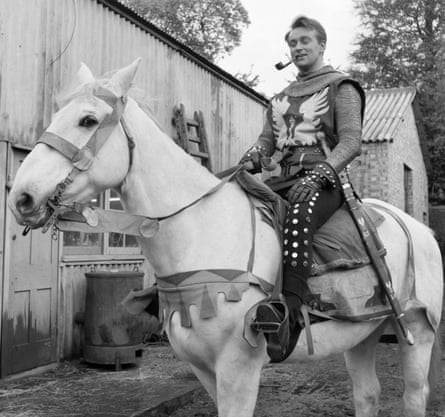
William Russell on the set of the 1950s television series The Adventures of Sir Lancelot. Photograph: Mirrorpix/Getty Images
When Sir Lancelot went to the US, the first British TV import to be shot in colour for an American audience, Russell rode down Fifth Avenue on a horse in full regalia, like some returning, mystical, medieval knight in the heart of Normandy. The show was a smash hit.
By now he was established in movies, playing a servant to John Mills in The Gift Horse (1952) and a clutch of second world war action movies including They Who Dare (1954) opposite Dirk Bogarde, directed by Lewis “All Quiet on the Western Front” Milestone – he met his first wife, the French model and actor Balbina Gutierrez on a boat sailing to Cyprus to a location shoot in Malta – and Ronald Neame’s The Man Who Never Was (1956), the first Operation Mincemeat movie, in which he played Gloria Grahame’s fiance.
Until this point in his career, he was known as Russell Enoch. But Norman Wisdom, with whom he played in the knockabout comedy farce One Good Turn (1955) objected to his surname because he felt (oddly) that it would publicise a vaudevillian rival of his called Enoch. So, somewhat meekly, and to keep Wisdom happy, he became William Russell, although, in the 1980s, for happy and productive periods with the Actors Touring Company and the RSC, he reverted to the name Russell Enoch. Later, he settled again on William Russell. All very confusing for the historians. His doorbell across the road from me in north London bore the legend “Enoch”.
He was born in Sunderland, the only child of Alfred Enoch, a salesman and small business entrepreneur, and his wife, Eva (nee Pile). They moved to Solihull, and then Wolverhampton, where William attended the grammar school before moving on to Fettes college in Edinburgh and Trinity College, Oxford, where his economics tutor was the brilliant Labour parliamentarian Anthony Crosland.
But Russell didn’t “get” the economics part of the PPE (philosophy, politics and economics) course and switched, much to Crosland’s relief, to English. In those years, 1943-46, he worked out his national service and appeared in revues and plays with such talented contemporaries as Kenneth Tynan, Tony Richardson and Sandy Wilson.
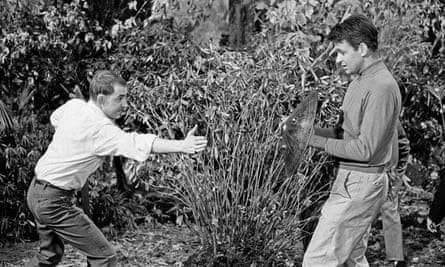
Derek Ware, a fight co-ordinator, runs through a scene with Russell during a break in filming the Doctor Who story The Crusades at the BBC studios, Ealing, in 1965. Photograph: Mirrorpix/Getty Images
On graduating, he played in weekly rep in Tunbridge Wells, fortnightly rep at the Oxford Playhouse and featured, modestly, in the Alec Guinness Hamlet of 1951 at the New (now the Noël Coward) theatre. He had big roles in seasons at the Bristol Old Vic and the Oxford Playhouse in the early 60s, while on television he was in JB Priestley’s An Inspector Calls with John Gregson, and was St John Rivers in Jane Eyre.
He played Shylock and Ford (in the Merry Wives of Windsor) in 1968-69 at the Open Air, Regent’s Park, before joining the RSC in 1970 as the Provost in Measure for Measure (with Ian Richardson and Ben Kingsley), Lord Rivers in Norman Rodway’s Richard III and Salisbury in a touring King John, with the title role played by Patrick Stewart.
His billing slipped in movies, but he played small parts in good films such as Superman (1978), starring Christopher Reeve, as one of the Elders; as a passerby drawn into the violence in the Spanish-American slasher film Deadly Manor (1990); and in Bertrand Tavernier’s Death Watch (1980), a sci-fi futuristic fable about celebrity, reality TV and corruption, starring Romy Schneider and Harvey Keitel.
With John Retallack’s Actors Touring Company in the 80s, he was a lurching, apoplectic Sir John Brute in John Vanbrugh’s The Provok’d Wife, possessing, said Jonathan Keates in the Guardian, “a weirdly philosophical elegance”; a civilised Alonso, expertly discharging some of the best speeches in The Tempest; and a quick-change virtuosic king, peasant, soldier and tsar in Alfred Jarry’s 1896 surrealist satire Ubu Roi in the Cyril Connolly translation.
Back at the RSC in 1989, he was the courtly official Egeus in white spats (Helena wore Doc Martens) in an outstanding production of A Midsummer Night’s Dream by John Caird, and both the Ghost and First Player in Mark Rylance’s pyjama-clad Hamlet directed by Ron Daniels. In 1994 he took over (from Peter Cellier) as Pinchard in Peter Hall’s delightful production of Feydeau’s Le Dindon, retitled in translation An Absolute Turkey, which it wasn’t.
He rejoined Rylance in that actor/director’s opening season in 1997 at the new Shakespeare’s Globe. He was King Charles VI of France in Henry V and Tutor to Tim in Thomas Middleton’s riotous Jacobean city comedy, A Chaste Maid in Cheapside. Many years later, in 2021, his son Alfred Enoch (Dean Thomas in the Harry Potter movies), would play on the same stage as a fired-up Romeo.
Russell is survived by his second wife, Etheline (nee Lewis), a doctor, whom he married in 1984, and their son, Alfred, and by his children, Vanessa, Laetitia and Robert, from his marriage to Balbina, which ended in divorce, and four grandchildren, James, Elise, Amy and Ayo.
William Russell Enoch, actor, born 19 November 1924; died 3 June 2024.
-- I'm a bit annoyed there's no mention of the fact that William continued to play Ian Chesterton for Big Finish.
95 notes
·
View notes
Photo
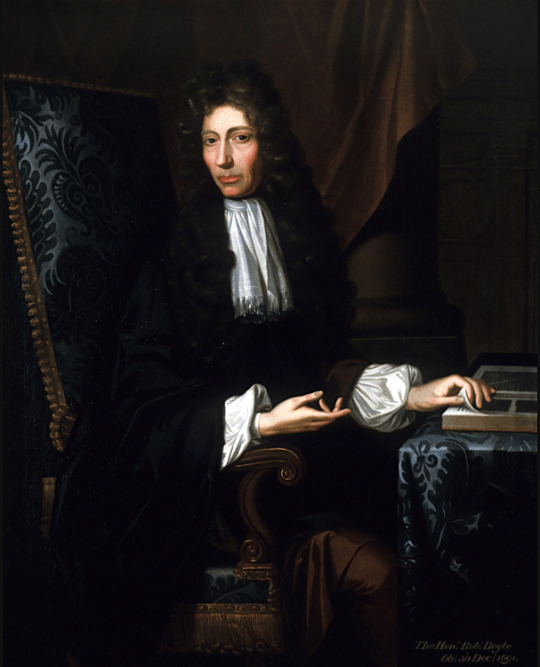
Robert Boyle
Robert Boyle (1627-1691) was an Anglo-Irish chemist, physicist, and experimental philosopher. Boyle was a prolific author, made significant experiments with air pumps, and presented the first litmus test. A founding member of the Royal Society, Boyle bequeathed funding for a long-lasting series of lectures, the Boyle Lectures, which aimed to show that the Christian faith and science were not incompatible.
Early Life
Robert Boyle was born on 25 January 1627 in Ireland. His father was Richard Boyle (1566-1643), the English landowner who later became the Earl of Cork. Robert was privately educated and then attended Eton College, but unusually for a leading figure of the Scientific Revolution, he did not study at a university. Boyle's education was rounded out by conducting a grand tour of Europe between 1639 and 1642, taking private lessons along the way with a tutor in tow. Robert lived in a manor house in Stalbridge, Dorset, in southern England from 1644, which was paid for by his father. In the mid-1650s, he moved to Oxford. In 1668, Boyle moved again, this time to Pall Mall in London, where he shared a home with his beloved sister Katherine.
Continue reading...
33 notes
·
View notes
Text
The poll is finished! Now for the infodump
Fallout AU Infodump Pt. 1

==Pt. 2 coming soon==
Jekyll was born and raised in the rural Scottish wasteland, bright eyed and intensely curious about the world around him. His talents in science were apparent from a young age and when a passing merchant mentioned an open vault that offered education to those that qualified the opportunity was quickly taken.
(Due to the fact that Fallout lore is primarily focused on the goings on in America and it’s themes around it being uniquely catered to its culture a lot of this will be my personal interpretations and hcs, it is subject to change)
Society in U.K. in the post nuclear apocalypse is somewhat intact, given its old but enduring infrastructure there’s a few settlements active in the area. London itself still remains as a city, albeit one with pockets of deadly radiation containing mutated rats, pigeons, insects, you name it. Due to the initial societal collapse at the end of the Great War and now the lack of fossil fuels the current culture of London has gone back in time to the Victorian era…with an apocalyptic twist of course. Streets lined with gas lamps now contain candles or certain glowing radioactive materials, markets now sell mutfruits, tatos, mole rat meat, you name it. But one of the important aspects of the city keeping it together is it’s open vault nestled in the upper class neighborhoods (a gift from the U.S. government to the British government) with its stable infrastructure, education, and resources. With something as valuable as this those who stepped foot in the vault were vetted before they could enter and those permitted to live there permanently even more-so.
Robert Hastie was a hard working wastelander, working his way to becoming a prolific merchant and eventually earning a place within a vault and starting a family. His son Lanyon was born and raised in the vault, living a quite literal sheltered life with privileges that those who lived outside could only dream of. He expected to coast through life as a doctor (a highly valued profession in such a place) and thinking that his classes would be a breeze. It was not. And that’s when he bumped into a rather roguishly handsome young man by the name of Henry Jekyll. Henry was granted temporary visitation in order to learn everything that he could about science with a hungry mind, utterly captivated by the well maintained prewar relic he was studying in.
In exchange for tutoring Lanyon Jekyll would hear many stories from him of what life was like the vault and even some information and stories he’s heard about what it was like before the war. Lanyon taught him how to speak in a proper British accent, how to dress well, how to use his charm, and they would grow closer and closer. A relationship like theirs was not meant to be in the vault, nor was it looked upon favorably in the city outside, so it was kept behind closed doors and lingering looks and late nights together…until it all came crashing down.
#the glass scientists#jekyll and hyde#tgs#dr jekyll and mr hyde#henry jekyll#tgs au#the glass scientists au#tgs jekyll#robert lanyon#tgs lanyon#fallout au#fallout 4#fallout 3#fallout uk#drawing#art#dyads scribbes#dyads rambles#tgs hastie#tw needle
95 notes
·
View notes
Text
Vincent Foredale, Earl of Edgewater - The man behind the title



Vincent Rupert Alexander August Foredale is the only son of Dominique Margaret (granddaughter of the Duke of Fydelia and daughter of his second-born son, the Cordonian ambassador to England) and the Earl of Edgewater, Rupert Archibald Foredale. He was named after an ancestor who was known for spying for both sides during the Wars of the Roses.
Despite Rupert's reluctance to break the tradition, due to Dominique's previous complications, he was born at the City of London Maternity Hospital on April 25, 1968. Vincent was the first Foredale baby not to be born on the Edgewater or at the family London Estate. In August of the same year, he was baptised at Moorefield Church. Queen Elizabeth II and his son, the Prince of Wales, were their godparents.
Contradicting the fears of breaking the tradition, Vincent was a healthy and playful baby.

Until the age of five, Vincent spent his days between the nursery and the gardens, playing with his neighbour and best friend, Matthew Sinclaire. Together, the two boys spent countless hours doing all kinds of mischief: scaring the swans of Edgewater Lake (and running away from them), playing with the hunting dogs (something Rupert had prohibited), playing pranks on the employees of both estates or simply eating mud like all the children do (yes, rich children eat mud too).
Determined to make his son a man in his image, Rupert hired a strict tutor who imposed on the boy a rigid study schedule, to which the Earl added even more rules.
Encouraged by his mother, Vincent did his best to meet his father's high expectations. Nevertheless, before his son's achievements, the Earl reacted with indifference or sharp criticism. Feeling that his best was never enough made Vincent grow apart from his father through the years.
For that reason, going to Eton at the age of thirteen was almost a liberation for him. Although the young viscount often chose books and chess, Vincent, along with Matthew and other companions, lived the typical young boys' adventures.
One of the things he learned during that time was how to ride a motorcycle. A colleague who lived in the city taught him and the other boys in an open field near the college.
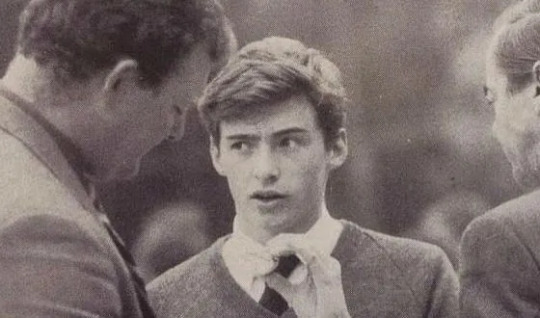
The exception was Miss Campbell (code name among Vincent's friends, 'Miss Candy Eyes'), the young man's first love. The girl worked after school at her parents' candy store in Windsor. Despite Matthew being the first to try to ask her out, the girl preferred to take out the quiet young Vincent. After those rendezvouses at Windsor, Vincent came back to Eton covered in sugar and cheap lipstick.
Still at Eton, Vincent discovered another passion – writing. Writing had become an escape for the teenage Vincent to deal with the turbulence of the adventure of growing up. His first experiences were some cheesy poems dedicated to Miss Campbell and a small Shakespearean-inspired play written for a literature class project. He tried to write a short novel but became too frustrated with its and his imperfections to continue the story.
After finishing his studies at Eton, and again following the old family tradition, he continued his studies at the University of Cambridge. There, he studied History and Political Science.
After a couple of years' break, Vincent ventured again into the universe of writing.
Inspired by the Cambridge atmosphere, Vincent drafted many stories, wrote several poems, and finished his first novel, a romance between an English spy and a French prostitute during the Napoleonic Wars. It had some flaws, but an editor showed interest in the story.
Unsurprisingly, Rupert did not allow the negotiations to move forward because "It was a waste of time, and being a writer was not a dignified occupation for a future Earl, especially a quixotic run-of-the-mill writer like you."
Feeling discouraged, he quit writing for years.
Despite Vincent having graduated with distinction, Rupert did not let him help with the family business or get a steady regular job. And God knows how Vincent tried. He knew his duty and knew he was capable of doing it.
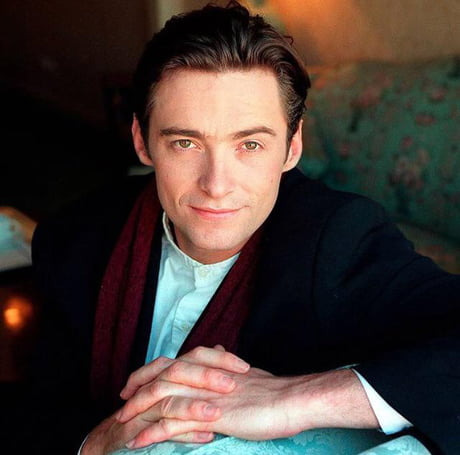
At the same time, his mother was trying to force him on every high-society girl he came across. Dominique insisted that getting married and having children would give him a purpose in life until he became an earl. To make her point, she didn't tire of talking in the case of his best friend, Matthew Sinclaire. The master of Ledford Park, once an epic rake, had fallen in love, and now it was an example of the wonders conjugal happiness brings to a man. In fact, Lydia Sinclaire herself had confirmed she was finally expecting.
He dated some of those women to please his mother, but never felt a connection with any of them. Furthermore, he did not wish to drag anyone into a relationship or marriage of convenience.
Frustrated and somewhat out of spite, Vincent allowed himself to get lost in the bohemian life of London's high society for some time. However, that only made his heart feel emptier. Fearing for his friend's sanity, Matthew helped him find a suitable job at the British Museum that not even Rupert could raise objections to.
In the meantime, Theodore and Matthew joined the countess on the mission to find him a girlfriend. The viscount was exasperated with the matchmakers.
One night, the Sinclaires threw a party at the Trafalgar St. James. As usual, he had spent the night running away from potential suitors and making small talk. Fed up with the fancy party, Vincent was considering leaving when he heard a voice that filled the imposing ballroom. It was the most beautiful thing he had ever witnessed. His heart stopped, but Vincent had never felt so alive.
Bewitched, he didn’t mind exposing himself to shame in front of the hundreds of illustrious guests to get a chance to see her again. Even if nervous, Vincent played and sang with all his heart, hoping to reach her heart. To this day, some of the party guests still remember his surprising performance.
Maybe Mary couldn't be considered extraordinarily beautiful by most people, but there was something unique about her that made him want to look at her for the rest of his life – Would be her bright eyes? Her sweet smile with a mischievous promise on her lips? The unruly waves of her chocolate hair?
If her voice and beauty had amazed him, her soul entranced him. Mary was different from any other woman Vincent had encountered.
Although, in her words, she was "poor, but the queen of herself," Mary had no problems opening her heart, talking about her dreams, the wounds she carried, the flaws she had... Mary was completely genuine in everything she said and did.
That night, he knew he was hopelessly, deeply, and wholeheartedly in love with her. When Mary fell asleep on his chest, Vincent thought he would die of happiness. Kissing her was as natural as breathing. It was the meeting of two souls.
For almost two years, Vincent lived in seventh heaven. He never felt so happy as he was with Mary. Whether it was a weekend away or a Sunday afternoon spent playing card games on the floor of Mary's flat (she was a very good player), all the moments together were sublime, the pinnacle of freedom and happiness. He was finally discovering his true self.
However, there was a shadow between them.
Outside their love bubble, his world was complicated and hard-hearted. He wanted to protect Mary from the weight of his duties, even if it involved some lies and omissions. Mary herself was in no hurry to enter this world. Although the world had changed, she was aware that Vincent would need some time.
Still and all, Vincent proposed to Mary, and she said yes. He still didn't know exactly how or when, but the queen of his heart would also be the queen of everything that was his.
In his dreams, Vincent would have offered her the family engagement ring. However, for now, the discreet diamond would have to be enough to witness their love.
But life tricked the young viscount. Weeks later they got engaged, Vincent found out his father had made some ruinous investments. After years of spending on pomp and pageantry, the family had no funds available. They were at risk of losing their properties and possessions. Matthew was working with him to find a solution, however, the more they dug, the more problems they found.
His heart was torn between his duty and Mary.
When his father proposed a marriage with Henrietta Marlcaster (widow of the fat cat Mr. Marlcaster), Vincent seriously considered eloping with Mary, but after some reflection, he decided to pretend to accept the arrangement to buy some more time.
The plan seemed to work for a while until, on one fateful February Sunday morning, his dreams shattered. The Sunday Times pompously announced to the world that the Viscount Vincent Foredale and the esteemed Lady Henrietta Marlcaster were engaged to be married. He didn't have time to break the news to Mary. She found out while waiting in line to buy bread for their Sunday breakfast.
Seeing Mary devastated because of him was the worst pain he had ever experienced. Even though she refused to see him, and wedding preparations had been hurried, Vincent kept fighting to get out of the engagement.
For the first time in his life, Vincent faced his father. Mary was worth a war with a battalion of enraged Rupert's.
Obviously, for his parents, giving up on the marriage with Henrietta was off the table. They needed her money to stay afloat. Besides, it would be a scandal.
The young viscount threatened them that he would give up everything to marry Mary. Rupert laughed disdainfully in his face.
“If she was, rich or had a title, maybe something could be done. But a singer coming from nowhere... that would be the final nail in our coffin.” Dominique appealed to her son.
After this argument, Vincent left home for a few weeks.
He looked for Mary everywhere. It seemed as if she had simply vanished into thin air. Vincent was desperate.
As the weeks passed, the creditors increased the pressure. His mother has started selling things. Every time he came home, something was missing. One day, on one of the rare occasions he was at Edgewater during that period, Vincent found his mother talking to an auctioneer. He was appraising the bust of Venus, a piece he knew that meant a lot to her. It was part of her dowry and one of her last connections to her homeland.
Seeing the sadness in her mother’s eyes made him feel guilty and selfish. Their family legacy was dying piece by piece.
"We mean more than ourselves. We are our legacy." Vincent had grown up under that mantra. That idea haunted his thoughts day and night.
During those troubled days, Vincent made the most difficult decision of his life. Since he had failed in love, he was determined not to fail in his duty. Even if that duty was making him deny his heart and principles.
So, on the 2nd of May 1994, he married Henrietta Marlcaster at Moorefield Church, in a sumptuous ceremony paid for by the bride.
As agreed, after the wedding, the new viscountess paid off half of the family's debts. The other half would only be paid when she had a child in her arms, her security for the rest of her life.
Pressured by the urgency of the situation, Vincent tried his best. His herculean effort paid off and shortly after, Henrietta got pregnant, and Harry was born on March 30 of 1995.
The duty was fulfilled: the debts were paid, Edgewater was rising from the ashes, and there was a new heir.
Satisfied that everything went as he had planned, Rupert changed his attitude towards Vincent, treating him like a "prodigal son." Unfortunately, the late redemption was not enough to heal their relationship. Vincent could not forget or forgive what had happened in his childhood, nor forced marriage, much less Mary's disappearance. Although he had no proof, Vincent had always suspected that it had been his father's work.
When Rupert Foredale died at the turn of the millennium, Vincent did not cry for his father's death.
He worked hard, but within a few years, Vincent had returned every penny to his wife.
Though, that didn't heal his heart. To ease his pain, he focused on his new family. Although the marriage started out as a nightmare, Vincent built a (most of the days) cordial relationship with his wife, maintaining a peaceful coexistence.
On the other hand, Edmund (Henrietta's son from her first marriage) and Harry were the centre of his world. Initially, Edmund did not react well to either the marriage or his brother's birth. After almost a year of attempts to get closer to the boy and a lot of tantrums, Edmund let Vincent into his life. The Earl was determined to learn from his father's mistakes and give his children the love and support he never felt.
At the same time, the new Earl resurrected the family's patronising and charitable spirit. The region's inhabitants noticed the difference in attitude between father and son. Vincent was approachable and kind-hearted, therefore, everyone felt free to come to him.
In all those years, there wasn't a single day that Vincent didn't think about Mary. He had never stopped loving her. He wondered where she was, if she had got married, if she had children, if she had moved to the USA... Every day he missed her more and regretted letting her go. Sometimes, he thought to look for her, but the more time passed, the more ashamed he felt about his actions. The last thing he wanted was to hurt her again with his ghost.
On an unusually sunny morning in December 2004, life had the biggest surprises in store for him.
When the friendly Mrs. Daly told him she was a friend of Mary's, Vincent almost fell out of his chair. It filled his heart with hope, just to be broken by the fatal news: Mary was dead. Vincent felt the cold taking over his body. For a few seconds, he couldn’t breathe. The pain in his heart spread throughout his body. Vincent thought he was going to die right then and there.
While he was still lost in the wave of pain and despair, Mrs. Daly revealed another plot twist: Mary had a child. He had a daughter. Their daughter. If only he had known that Mary was pregnant... How would their daughter be like? Would she be happy to meet him? There was a whirlwind of emotions in his heart. Vincent had never felt so sad and so happy in his life.
When Mrs. Daly told him the girl's name was Beatrice, his heart skipped a beat. Several times during their long pillow talks, they had talked that if they had a daughter, it would be Beatrice, "like the Dante's muse."
He was amazed. Vincent felt his heart melting in love as he saw the pictures of Beatrice. Tears fell uncontrollably down his cheeks, despite the wide smile on his face.
She was his second chance to love Mary, and he wouldn’t let his love down again.
Since day one, Beatrice was the light of his life, not only because of the love she represented but also because of the girl she was and became through the years. Father and daughter had a strong bond, which sometimes caused some misunderstandings between the children.
After Beatrice came into his life, Vincent felt like he was reborn. If life had given him that second chance, maybe it was time to pursue other dreams. Mainly encouraged by his daughter, Vincent came back to writing, and his "run-of-the-mill writing" won over the English and success beyond borders, as Mary had always predicted.
Matthew's death threatened to tear him apart. A part of himself had also been reduced to ashes in that fire, but now Vincent had a new responsibility - taking care of the legacy of his best friend and of his most precious treasure - Ernest. And Vincent did it with all of his heart.
Unfortunately, he continued to be haunted by the shadows for the rest of his days.
This is Vincent Foredale. A man who suffered as much as he loved. A man who fought for his dreams, silencing the mockers. A man who rebuilt his home from the ashes. A man who sacrificed himself for those he loved. A man who genuinely sought to help the disadvantaged. A man who never allowed the bitterness of life to harden his heart.


@jeanele ❣ @missameliep ❣ @regencylady1810 ❣ @i-put-the-sin-in-sinclaire @whenyourheartskipsabeat ❣ @xjustin-ethansgirliex ❣ @noesapphic ❣ @gardeningourmet ❣ @paisleylovergirl ❣ @dailydoseofchoices ❣ @rhyssescups ❣ @storyofmychoices ❣ @a-shining-lucky-star ❣ @lorircreates ❣ @lorirwritesfanfic ❣ @walkerduchess ❣@indiacater ❣ @kinkypot ❣ @anotherbeingsworld ❣ @hellooliviaolivia ❣ @pixel-writer19 ❣ @sinclaire-ity ❣ @darknessabovethelite ❣ @brightningstar ❣@ezekielbhandarivalleros ❣ @marlcasters ❣ @bhartigat81 ❣ @lyannacyrill706 ❣ @daddytyrilstarfury ❣ @secretaryunpaid ❣ @allisonreilynn ❣ @fauxleaves ❣ @twinkleallnight ❣ @kingliam2019 ❣ @iloveethanramsey ❣ @surewhyynot ❣ @yvettegolx ❣ @itlivesinpixelberry ❣ @chutchoices ❣ @electroniccreatorwerewolf ❣ @spookycolorpeanut ❣ @peonierose ❣ @quixoticdreamer16 ❣ @lilyoffandoms ❣ @tessa-liam
43 notes
·
View notes
Text
In the metamorph AU (which is hp cross but so far I'm focusing on pre Hogwarts stuff)
The Hooligans despite being kids have literally done diamond heists and other crazy stuff, but when your leader is a shapeshifter who can seemingly alter reality around him plus the confidence kids can have they feel they can take on the world
Fang's magic is wild yet controlled he just wishes for things to happen and they do
Not to mention who the hell expects a trio of 11yr olds to be stealing diamonds and pulling of full blown heists
In fact he doesn't even go to Hogwarts, upon finding out fully about the magic world his goal is rob em blind
Also Jewel is in this AU, she's human because mobians don't exist Fang is just a morphed human though his animal traits are part of his genome by this point
Anyway they meet her when they tour around a museum for a heist, she's on a school trip and Bark immediately crushes on her, much to Fang's annoyance from where he's in Bark's backpack
Jewel actually begins tutoring Bark and eventually meets the walking breaker of the secret that magic exists
She doesn't react well at first to a giant rat thing but she gets better about it even if the fact that he was once a human confuses her
Finding out about magic was a relief because at least her friend wasn't some type of unethical science experiment
Bark, Bean and Jewel do get arrested at one point for taking part in a gay rights protest turned riot in 1993 in the middle of London (yes they ended up in a riot at 13 for Jewel it was not planned but Bark enjoyed getting to punch a cop)
Fang breaks them out and they take off on the queen
#metamorph au#fang the sniper#fang the hunter#nack the weasel#sonic the hedgehog#sonic au#sth au#crossover au#harry potter#harry potter au#bark the polar bear#bean the dynamite#jewel the beetle
3 notes
·
View notes
Text
Photographs of Tsar Nicholas II and family go on show at Science Museum in London. The images were captured by Herbert Galloway Stuart, an English tutor to the nephews of Tsar Nicholas II, between 1908 and 1916. They were unearthed by chance at the National Science and Media Museum in Bradford

Tsar Nicolas II and family at St Petersburg, 1915.

Children of the Imperial family at Gatchina Palace, outside St Petersburg

Boating at Gatchina Palace!

Lunch during a hunting trip with Tsar Nicholas II.
18 notes
·
View notes
Text
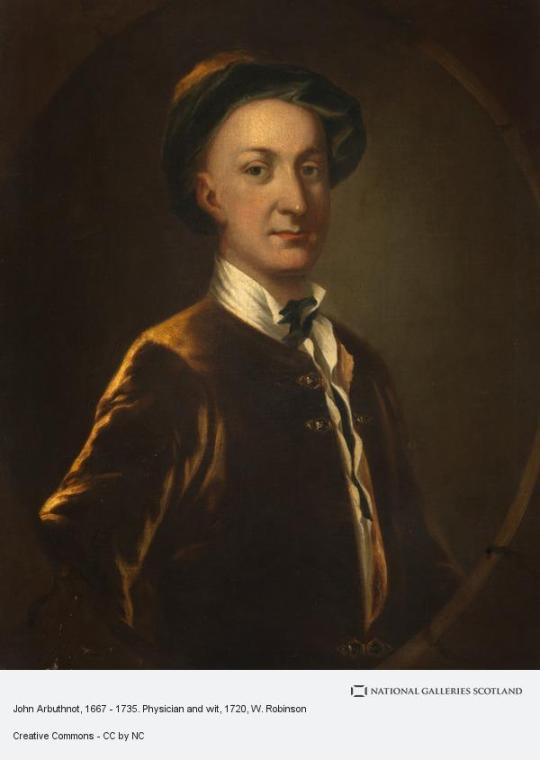
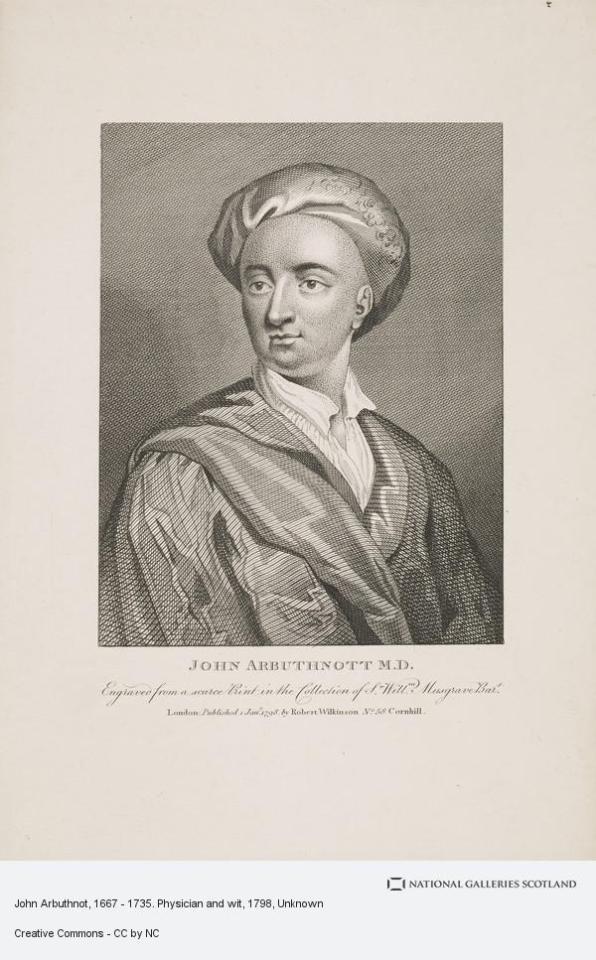

Scottish scholar mathematician, physician and satirist , John Arbuthnot was born in on 29th April 1667.
Born in the county of Kincardineshire, the son of an Episcopalian priest. These were turbulent times for Scotland and the Jacobites and it is not known for certain where he was educated, although suggestions are that he went to Aberdeen’s Marischal College and gained a degree. By 1691 he had moved to London and taught mathematics for a while. He had a keen interest in science and, the following year, translated from the original Dutch a book called Of the Law and chance .
John Arbuthnot was an intellectually gifted man who was a satirist, physician and mathematician. He is often described as a true polymath and was responsible for the invention, in 1712, of a character named John Bull who would go on to symbolise “middle England” in political and sociological posters, pamphlets and publications. He was one of the founder members of a London literary group called the Scriblerus Club, other members including famous writers Alexander Pope and Jonathan Swift.
Although this work was a success Arbuthnot was struggling financially, a situation eased by a number of tutoring posts that he filled during the next few years. He decided to become a student himself, again, when enrolling on a doctor of medicine course at the University of St Andrews in September 1696. However it was deemed unnecessary for him to take the course, the college awarding him the doctorate on the strength of seven theses on medicine presented on the day of his enrolment.
During the early years of the 18th century Arbuthnot was reading works of a scientific nature with a growing sense of scorn and decided to respond to them with satire. This was the beginning of his time as a noted satirist but, apart from that, he was also being favoured in royal circles. He became close to Prince George of Denmark and the English Queen Anne and, no doubt with their patronage, he became a Fellow of the Royal Society in 1704. The following year Cambridge University made him an MD.
It seems that, despite his academic and social achievements, Arbuthnot found it hard to take his own work, and that of others, seriously. He was quick to attack people seen to act scandalously, or outside the laws of human decency, and yet many saw him as an amiable sort of chap. He certainly held favour at the royal court and these connections ensured that he presented himself as a figure of some importance, as well as one of great modesty.
By the mid-1730s his health was failing. He was overweight and suffering with kidney stones and asthma and announced to his friends that he was dying.
John Arbuthnot died in London on the 27th February 1735, aged 67
More detail on his life can be found here https://history.rcplondon.ac.uk/inspiring.../john-arbuthnot
4 notes
·
View notes
Text


ciao baby !! i’m april (she/her), i’m 22, i’m in est, and i cannot articulate how EXCITED i am to get this rodeo going. with that being said, si si spaghetti baby let’s talk about this absolute fucking mess of a man. trigger warnings for everything below [and most interactions with chan in general] include: drugs, addiction, and mental health issues.
full app. && pinterest.
(tldr; boy genius has a low tolerance for most other people but a high tolerance for anything that can be snorted, sniffed, or swallowed. can be quite cruel and patronizing and mean around the edges, but is easily pacified if you offer him something sweet and chewy or caffeinated and liquid. heir to a billion-dollar tech company in ole silicon valley, has probably spent many-a dinner party face-to-face with mark zuck’s cold, dead gaze.)
&& basics —
full name: seung-chan park
nicknames: chan (primary), park, channy (only by sisters)
gender & pronouns: cismale & he/him
sexuality: bisexual
age & dob: twenty-one & october 22nd
hometown: london, england
education: double-major in mathematics & computer science
favorite proof: big fan of demoivre’s theorem
&& background —
chan’s mom comes from an old money real estate/investment empire in south korea, chan’s dad is just some broke man. but! they fall in love, they move to london, they have two daughters, and then chan’s mom decides to take a gamble and make her own tech company in the us of a (do NOT ask me what this company is but it’s like…. probably software probably pretty famous idk maybe salesforce-esque where it’s useful but not glamorous)
it’s a massive success! chan’s mom becomes a hotshot in silicon valley so she’s rarely around the rest of her family in london, chan’s dad becomes resentful because she’s abandoned their family to go be a big deal with the tech bros (and because he’s got some fragile masculinity going on let’s be real). this is how the park family is supposed to remain until…..
SURPRISE! mrs. park gets pregnant by accident, and it’s a BOY, so chan’s dad insists that they keep it because he’s always wanted a son. enter stage left: SEUNG-CHAN PARK, but you can call him chan.
he’s smart. like, really really smart. every rich kid with a brain and privat tutors can do alright for themselves, but chan is exceptionally gifted, especially when it comes to numbers and logic
buuuuut his social skills are atrocious! he’s blunt, he’s condescending, he doesn’t know how to play nice with the other kids because he thinks he’s better than them. he becomes a bit of a zoo attraction – marvel at his genius from behind the bars, but don’t get much closer than that or he’ll bite. and that’s fine with him! his best friend is his dad and chan doesn’t need much more than that
when he’s thirteen, his mom offers him a silicon valley job, and he reluctantly takes it. he spends every summer coding for her company, and as it turns out, being a nepo baby doesn’t save him from the long hours and high demands of the job.
he accepts his first dose of adderall from a fellow coder when he’s sixteen. finally, it starts to feel like his fingers can move as fast as his brain does. next comes ritalin, amphetamines, ecstasy, cocaine. by the time he graduates high school (as valedictorian, predictably), it’s safe to say that he’s got a hefty drug problem.
the jig is up in his second year at meraviglia, when his dad walks in on his room that looks very much like what you’d expect from a 20 yo drug addict. this fundamentally ruins his relationship with his dad (sad), mama and papa park send him away to rehab for a drug-free summer (sadder), and this is CHAN’S BIG SECRET :O his parents told everyone he was spending a summer traveling abroad, meanwhile he was really in a luxury rehab center in zurich
since then….. he has relapsed (saddest). he does feel a bit more guilty about doing drugs now than before, especially because he knows how much it would disappoint his dad, and he also feels quite bad about keeping the fact that he went to rehab from his friend(s) (probably just cypress). he drinks and gets high with the rest of praeditus like it’s business as usual, but they’re all unaware that he’s doing it a little more than just recreationally
&& tidbits — (these are copy/pasted directly from my app and are rlly not that important, i just think they’re fun to know for plots/interaction xx)
doesn’t know how to cook (blames it on growing up rich and always managing to live with people who took care of the food), so his diet is more or less a mess now that he lives alone. unless he finds the time to visit a dining hall, he survives off coffee, candy, energy drinks, pastries, the occasional doordash order, and more coffee. it takes him way too long to remember the last time he sought out a vegetable
responds to “seung-chan” and “chan” and “park” pretty interchangeably, but his sisters like to mess with him and call him “channy”. needless to say, he hates it
his mom is certain that after graduating he’ll come back to california and work with her in silicon valley, but chan’s not so sure anymore. coding on his own for his classes is starting to make him wonder if he wants something that’s just his own, something where he can flex his creative muscles a bit more
when the right opportunity strikes, he can be shockingly funny. not in the way asphodel is, of course – an easy and open humor, the kind that’s meant to be heard by a crowd – but rather in the form of dry sarcasm and biting remarks. it tends to surprise people the first couple of times he can make them laugh, especially because he usually isn’t trying to, he’s just making a blunt statement that happens to double as a joke
never learned how to sit normally on a surface. an eternity of bending over notebooks and computers has fucked up his body to the point of no return, and so he sits wherever and however is most comfortable to him in that moment – back bent over armchairs, legs crossed on countertops, head hanging off the bed with one thigh crossed over the other. if he didn’t think yoga was for assholes then it would probably change his life
despite his ongoing reliance on a number of vices, he only drinks in social settings, and even then, he never drinks too much. he’s not a fan of how alcohol tends to slow him down and make him disoriented – plus, he tends to find that his actions feel much more unpredictable with a couple drinks than with a couple lines. if he does drink, he’s definitely a fruity and sweet cocktail man, don’t even think about coming close to him with a fucking bud light
his fashion sense is abysmal. he wears sweaters and t-shirts that range anywhere from neutral to ugly, and he pairs them with joggers and birks on a daily basis. he accepts no comments or complaints, insisting that fashion should first and foremost be for comfort
doesn’t take criticism very well? or like, at all? he’s been told he’s brilliant and always right and etc etc so much throughout his life that on the off chance he does get something wrong he simply refuses to believe it and will argue otherwise until proven guilty. he usually requires a full-fledged derivative proof, and even then he’s dubious
takes his coffee black, but you already knew that. often puts an extra espresso shot in it for good measure
he’s not an easy person to like, and he recognizes that, but he’s also not taking any tangible steps to fix it. even when somebody does like him and he enjoys them too, he has the most bizarre ways of showing affection that half the time it still may feel like chan thinks you’re stupid because he’s bitter and sarcastic and impatient just as the status quo
he speaks four languages fluently (english, korean, italian, and chinese), three conversationally (swahili, japanese, and spanish), and a bunch of others casually. his dad was always really insistent on him learning languages, and on top of that, he went through a linguistics phase in middle school
owns a cat called copurrnicus in his off-campus apartment, and he would pretty much kill for her. sources say that the only time they’ve seen him giggle is when her little paws get tangled in his sweaters
7 notes
·
View notes
Text

A ligação dos Beatles com o satanismo e os illuminati
Compilação de textos e imagens por Cláudio Tsuyoshi Suenaga
Este é apenas uma pequena parte de minha reportagem "O pacto de John Lennon com o Diabo e a seara satânica dos Beatles". Apoie-me no Patreon e tenha acesso exclusivo a este material inédito.
youtube
Os 55 anos do lançamento (em 26 de maio de 1967 no Reino Unido e em 2 de junho nos Estados Unidos) de Sgt. Pepper’s Lonely Hearts Club Band, aquele que é considerado um dos discos que mais revolucionaram não apenas o universo da música, mas o mundo das capas de discos – ao reunir nada menos do que 61 pessoas, a maioria famosas, em uma única cena, sendo que 50 anos depois apenas cinco delas continuam vivas, incluindo dois integrantes da banda (Paul McCartney e Ringo Starr), além dos cantores Bob Dylan e Dion DiMucci e do escultor Larry Bell –, incita-nos a abordar a questão tão cogitada de se os Beatles, em particular John Lennon, fizeram ou não um pacto com o Diabo, assim como admitiram Bob Dylan e muitos outros músicos, para angariar fama, sucesso e dinheiro.
Seja você um beatlemaníaco ou não, veja e leia os quadros que preparei abaixo e tire você mesmo suas próprias conclusões.
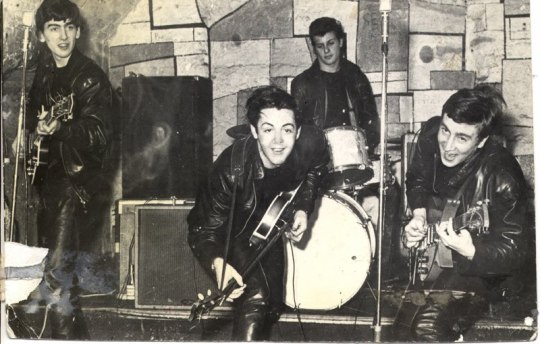
Os Beatles em 1961, ainda com o primeiro baterista, Randolph Pete Best, quando começaram a tocar no Cavern Club, em Liverpool. Foto de Dick Matthews.
O nome foi sugerido por Stuart Sutcliffe (1940-1962), primeiro baixista da banda. Stu era admirador da banda Crickets (grilos) de Buddy Holly e sugeriu o nome The Silver Beetles (besouros prateados), depois abreviado para apenas Beetles. Lennon sugeriu que usassem Beatles ao invés de Beetles como uma referência a “beat”, que significa batida ou ritmo.

Ocorre que o besouro ou escaravelho é um antigo símbolo do Antigo Egito. Os egípcios adoravam o besouro por ele ser capaz de, conforme a ciência biológica só descobriu recentemente, guiar-se pelas estrelas. Embora os olhos compostos desse inseto sejam fracos demais para ver estrelas individuais, sabe-se hoje que eles utilizam a luz da Via Láctea para manter o curso.
Aplicando um experimento incomum, biólogos da Universidade de Witwatersrand, na África do Sul, colocaram escaravelhos sob o céu artificial de um planetário local e constataram que a Via Láctea forneceu aos insetos um “compasso de luz”, ajudando-os a seguir em linha reta com o seu “tesouro”, uma bola de estrume. Alguns animais, como as focas, algumas aves e os próprios humanos, usam estrelas para navegação, mas o escaravelho é o primeiro inseto a comprovadamente utilizar a própria galáxia para se orientar.

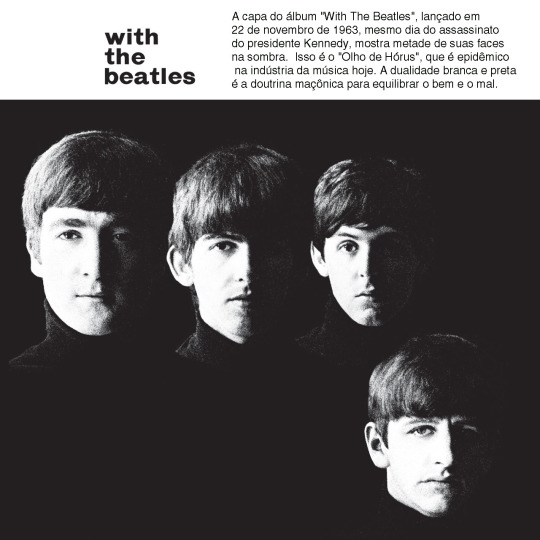
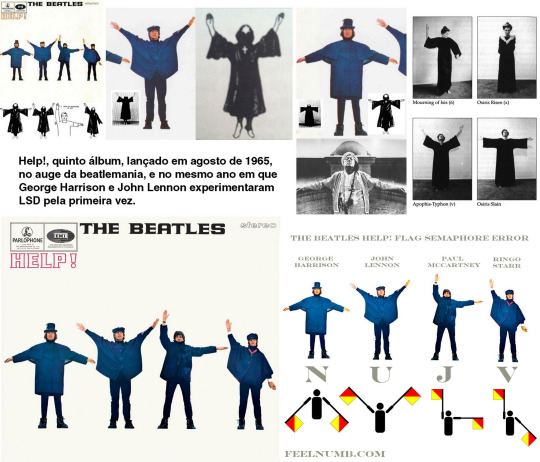
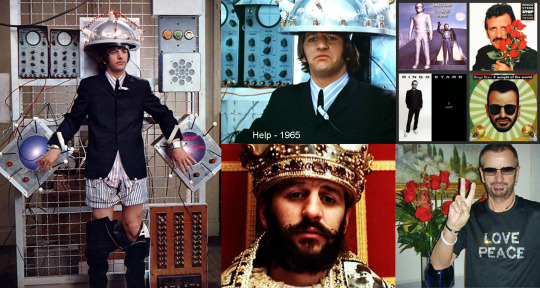

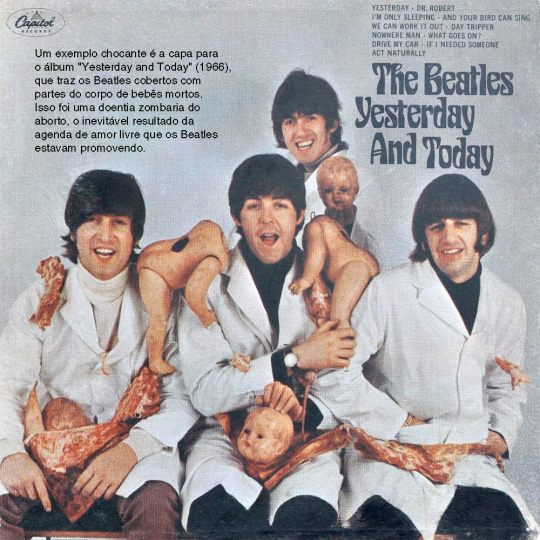

David Richards, em seu artigo “Os Beatles foram uma criação maçônica”, escreveu: “No filme, The Magical Mystery Tour (A Turnê Misteriosa Mágica), os Beatles usam um bastão mágico para arremessar feitiços sobre membros insuspeitos do público. Bastões mágicos são feitos de árvores santas (por isso Holly-wood) e são o instrumento da magia oculta que tem sua audiência (a populaça) em um transe. O filme exibe vários apertos de mão maçônicos.”
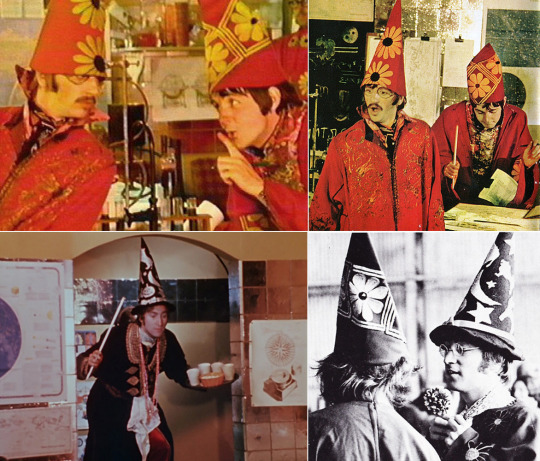
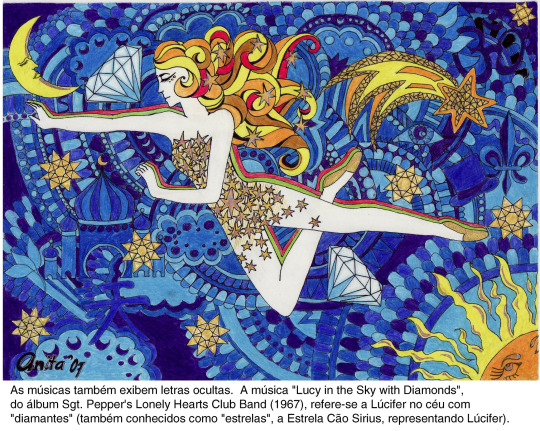
A colagem na capa do álbum Sgt. Pepper's Lonely Hearts Club Band (1967) está cheia de simbolismo maçônico-ocultista-satanista-illuminati e traz uma uma hoste inteira de personagens cabalistas, incluindo (a pedido de George Harrison) nada menos do que quatro gurus indianos, entre eles Swami Sri Yukteswar Giri, cujo livro The Holy Science propunha uma "religião única mundial".
Entre as mais de 70 pessoas famosas, há 11 maçons representados, e destes 11, 3 são do grau 33: Karl Marx, H. G. Wells e Aleister Crowley. O avô de Aldous Huxley, Thomas Huxley, ensinou H. G. Wells. Thomas Huxley era um membro da Royal Society of London, que foi fundada em 1660 por maçons, e foi extremamente influenciado por Sir Francis Bacon e seu livro A New Atlantis. H. G. Wells mais tarde foi tutor de Aldous Huxley em Oxford, além de ser o chefe da Inteligência Bntânica (MI6) durante a Segunda Guerra Mundial. Wells apresentou Aldous Huxley a Aleister Crowley (a "Besta 666", co-fundador do Instituto Tavistock) em Berlim em 1930, onde Crowley o introduziu no uso do peyote.
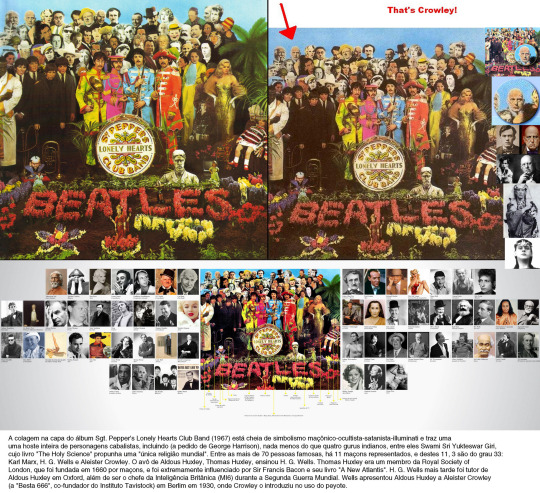
Todos os personagens presentes na capa também são uma referência explícita ao uso de intelectuais, literatos, artistas, estrelas de cinema e todo tipo de celebridades para a manipulação das massas pelo programa de controle mental do Instituto Tavistock e do MK-ULTRA, com destaque para os psicanalistas Sigmund Freud e Carl Jung (que forneceram as bases e a inspiração para o programa de controle mental do Tavistock), Lewis Carroll (cujos livros foram usados pelo Tavistock para programar a mente de crianças), Marilyn Monroe (escrava sexual controlada pelo MK-ULTRA) e Shirley Temple (atriz precoce cujo marido era diretor da Stanford Research Institute, um dos ramos do Tavistock). Na extrema direita inferior da capa, há a boneca de pano de Shirley Temple vestida com um pulôver com os dizeres "Welcome the Rolling Stones". Ha manchas no vestido da boneca que são interpretadas como sendo sangue.

Cabe destacar ainda as figuras de Edgar Allan Poe (autor de contos góticos, satânicos e de demência obsessiva), George Bernard Shaw (co-fundador da Sociedade Fabiana), W. C. Fields (comediante e ator, um dos criadores da comédia burlesca e conhecido por seu mau humor, misantropia - odiava crianças, cães e mulheres - e alcoolismo), Mae West (promotora da "Revolução Sexual" nos anos 1920), Dylan Thomas (ídolo para a geração dos poetas da chamada Geração Beat, autor do altamente revelador poema Illuminati "My World Is Pyramid"), Bob Dylan (que mudou o seu nome em homenagem a Dylan Thomas e confessou ter feito um pacto com o diabo), Stuart Sutcliffe (o quinto Beatle que aos 21 anos, em 10 de abril de 1962, morreu de hemorragia cerebral um dia antes dos Beatles voltarem da Alemanha) e Lenny Bruce (comediante que usava obscenidades para promover a Revolução Cultural dos anos 60). Entre as estátuas, há uma de um gnomo, de Shiva, a deusa da destruição e da transformação, e uma boneca japonesa Fukusuke, deusa xintoísta da fortuna.
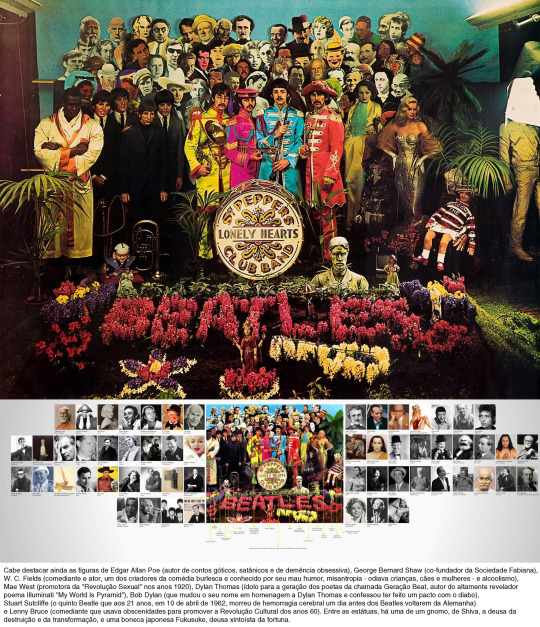
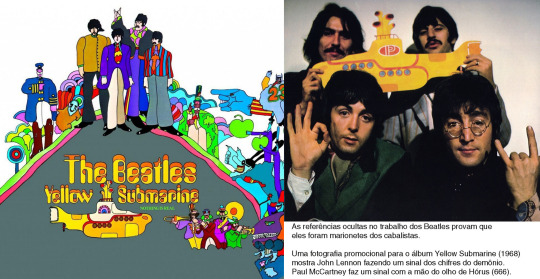

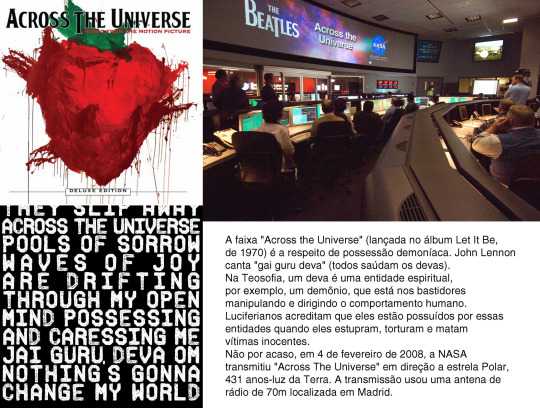



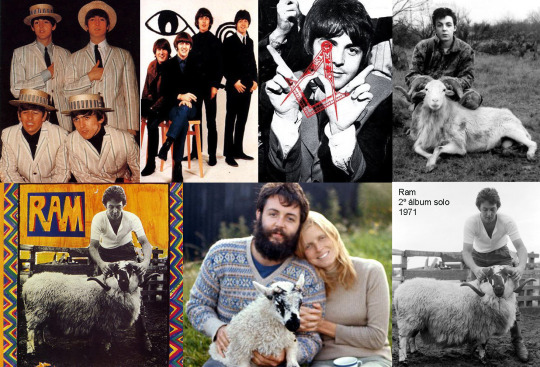

O Bebê de Rosemary, roteirizado e dirigido por Roman Polanski em 1968, baseado no romance homônimo de Ira Levin publicado em 1967, e a capa de Imagine, de John Lennon, o segundo álbum de estúdio do ex-beatle John Lennon, gravado e lançado em 1971.
Várias maldições atingiram os que estavam envolvidos no filme O Bebê de Rosemary.
O produtor William Castle, em abril de 1969, é internado com falência renal. Na sala de cirurgia do hospital, testemunhas afirmam tê-lo ouvido delirar dizendo: “Rosemary, pelo amor de Deus, solte esta faca!” No final do filme, após descobrir que seu filho foi resultado do ato sexual com o demônio, Rosemary aparece próxima do berço do amaldiçoado filho, com uma faca, dando a entender que pretende matar a criança.
No mesmo dia, e no mesmo hospital, estava Krysztof Komeda, compositor da trilha sonora do filme e grande amigo do diretor Polanski e de sua esposa, Sharon Tate. Assim como Hutch, o amigo de Rosemary no filme, Komeda também morre por causa de um coágulo no cérebro.
Em agosto do mesmo ano, Sharon Tate, esposa do diretor do filme, é assassinada a facadas por quatro fanáticos liderados pelo lunático Charles Manson, fundador de uma pequena seita satânica reclusa da Califórnia. Assim como Rosemary, Sharon estava grávida. Mais quatro pessoas morreram no ataque ocorrido na casa de Polanski.
Na porta do local, os criminosos escreveram “porco” com o sangue das vítimas. Esse crime ficou conhecido como “Helter Skelter”, nome de uma música dos Beatles (a expressão significa “caos”, “decadência”). Manson era grande fã do quarteto de Liverpool.
A última coincidência, ou não, aconteceu vários anos depois do lançamento do filme, quando John Lennon é assassinado em Nova York bem na porta do prédio onde morava, o Edifício Dakota, o mesmo onde se passava a trama de O Bebê de Rosemary.

O Edifício Dakota, edifício em estilo art nouveau construído entre 1880 e 1884, situado na esquina da 72nd Street e Central Park West, em Manhattan, Nova York, onde os satanistas do filme O Bebê de Rosemary moravam e praticavam seus rituais. John Lennon se mudou justamente para esse edifício em 1973 e bem em frente a ele acabou sendo assassinado por Mark David Chapman em 8 de dezembro de 1980. A viúva de Lennon, Yoko Ono, ainda tem vários apartamentos no mesmo edifício!




Este é apenas uma pequena parte de minha reportagem "O pacto de John Lennon com o Diabo e a seara satânica dos Beatles". Apoie-me no Patreon e tenha acesso exclusivo a este material inédito.
#the beatles#john lennon#paul mccartney#satanismo#illuminati#ocultismo#maçonaria#sgt peppers lonely hearts club band#Youtube
20 notes
·
View notes
Text
Court Circular | 8th February 2023
Buckingham Palace
The King and The Queen Consort this morning visited Altab Ali Park, Adler Street, London E1, and were received by His Majesty’s Lord-Lieutenant of Greater London (Sir Kenneth Olisa).
His Majesty, escorted by the Joint Founder of British Bangladeshi Power and Inspiration (Ms Ayesha Qureshi), and Her Majesty, escorted by Mr Abdal Ullah (Joint Founder), viewed the Park and met members of the local community.
The King and The Queen Consort afterwards visited Brick Lane, London E2, and, having been received by Her Excellency the High Commissioner of Bangladesh (Ms Saida Muna Tasneem), walked along Brick Lane meeting representatives of the local community.
Their Majesties subsequently visited Brick Lane Mosque, were received by the Treasurer of Brick Lane Mosque Trust (Mr Hamidur Rahman Choudhury) and met members from faith, business, charity and Covid-19-impacted communities.
The King this afternoon opened a new frontline medical teaching hub at the University of East London, Stratford Campus, Water Lane, London E15, to mark the University’s One Hundred and Twenty Fifth Anniversary, and was received by the Chancellor (Mr Shabir Randeree) and Mr John Garwood (Chairman of the Board of Governors).
His Majesty, escorted by Professor Amanda Broderick (Vice Chancellor and President), toured the Hospital and Primary Care Training Hub, visiting the Baby Development Laboratory, the Intensive Care Ward and the Interdisciplinary Healthcare Ward and meeting students.
The King afterwards viewed an Environmental Sustainability Exhibition in the Great Hall and met students and tutors.
The President of Ukraine later visited His Majesty.
The Queen Consort, Colonel-in-Chief, The Rifles, this afternoon received General Sir Patrick Sanders (Colonel Commandant).
Kensington Palace
The Princess of Wales, Patron, Captain Harpreet Chandi’s Solo Antarctic Expedition, this morning visited Landau Forte College, Fox Street, Derby, and was received by His Majesty’s Lord-Lieutenant of Derbyshire (Mrs Elizabeth Fothergill).
St James’s Palace
The Countess of Wessex, Patron, the Scar Free Foundation, this morning visited the Royal College of Surgeons of England, 38-43 Lincoln’s Inn Fields, London, WC2, to mark the United Nations International Women and Girls in Science Day, and was received by Ms. Geraldine Norris (Deputy Lieutenant of Greater London).
Her Royal Highness, Patron, Toronto General and Western Hospital, this afternoon held a Meeting.
The Countess of Wessex, Chairman, Women in Business Committee, The Duke of Edinburgh’s Award, later chaired a Meeting at Buckingham Palace.
St James’s Palace
The Princess Royal, Patron, Scottish Rugby Union, Royal Patron, Motor Neurone Disease Association, and Royal Patron, MND Scotland, accompanied by Vice Admiral Sir Tim Laurence, today started the My Name’5 Doddie Foundation Charity Cycle Ride at Kingsholm Rugby Ground, Kingsholm Road, Gloucester, and was received by Mr Philip Vickery (Deputy Lieutenant of Gloucestershire).
Kensington Palace
The Duchess of Gloucester, Colonel-in-Chief, Royal Army Dental Corps, today received Colonel Irene Amberton upon relinquishing her appointment as Colonel Commandant and Major General Ewan Carmichael upon assuming the appointment.
#court circular#princess anne#princess royal#tim laurence#king charles iii#queen camilla#catherine princess of wales#countess of wessex#duchess of gloucester#british royal family
10 notes
·
View notes
Photo


Beatriz and Maria Cristina de Borbon y Battenberg
They were the daughters of King Alfonso XIII of Spain and Victoria Eugenia of Battenberg. Beatriz and her sister Maria Cristina, two years her junior, yearned to go to private schools like the daughters of the nobility who frequented the palace as their playmates, but, following Spanish tradition, they were educated by governesses and private tutors. A British teacher gave them Mathematics, Geometry, Astronomy and Natural Sciences and another French teacher gave them lessons in Geography, History, Language and Literature.
Baby and Crista, as they were called, spoke perfect English, French and German and were fluent in sign language, which they learned to communicate with their deaf-mute brother, the infant Jaime.They learned to play the piano with the famous Polish concert artist Caroline Peczenik, and to dance with Miss Marguerite Vacani.The two sisters were great horsewomen, excellent golf and tennis players, and enthusiastic rowers and athletes.
During the late 1920s, Beatriz and Cristina presided at a number of official engagements while heading various institutions and sponsoring events. They were involved with, among other issues, animal protection. They took nursing classes, helping twice a week at the Red Cross in Madrid from 9 am to 1 pm and from 3 to 7 pm. Beatriz was president of the Red Cross in San Sebastián, working there during the royal family's summer vacation. Baby and Crista made some visits to England to stay with their maternal grandmother at Kensington Palace.

The two infantas, always elegantly dressed, were of contrasting looks; one blonde one dark. Beatriz, who resembled her Spanish relatives, was a brunette, tall and lean like her father. Baby and Crista lived their youth stigmatized by hemophilia, disease suffered by two of their brothers, Prince Alfonso and Infante Gonzalo, and which they themselves could be carriers. Queen Victoria Eugenia knew that it would be difficult for her daughters to have royal marriages.
The proclamation of the Second Spanish Republic forced the royal family to go into exile. Baby and Crista were 21 and 19 years old, respectively.The marriage of their parents was unhappy and even in Spain the King and Queen led separate lives. Once in exile, the royal couple separated permanently. Baby and Crista lived with their mother in Paris, London and Lausanne, and with their father in Rome. In 1934 tragedy struck. Beatriz, who was spending summer vacation in Pörtschach am Wörthersee in Austria, was driving a car with her brother Gonzalo as passenger. Trying to avoid a bicycle rider who had crossed their path, she slammed the car into a wall. The accident did not, at first, seem serious, but Infante Gonzalo, a hemophiliac, was bleeding internally and died.
When Baby and Crista had the opportunity to return to Spain, after the restoration of the monarchy at the hands of their nephew, King Juan Carlos, they had already spent almost half a century in exile and were grandmothers. The two sisters married Italians. Beatriz with Alessandro Torlonia, Prince di Civitella-Cesi, and Cristina with Count Enrico Marone-Cinzano.
#Beatriz de Borbón#Maria Cristina de Borbón#Baby y Crista#Alfonso XIII#Victoria Eugenia of Battenberg#Women in history#Spanish history
20 notes
·
View notes
Text
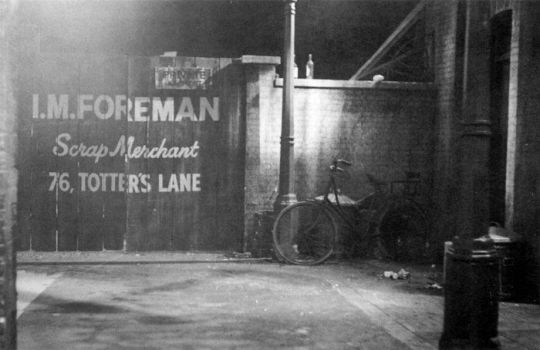
On a late foggy London night, a police-officer makes his rounds, only to trend down trotters lane. Upon which he hears a faint humming noise, which leads him to the blue gates of a scrapyard. He dares to open them, only to find a blue police box tucked inside.
Dun. Dun. Duunn.
That’s it though. We never see him again. He’s completely irrelevant and he doesn’t even die.
What nonsense is this?
Episode one of Classic Who
Full explanation and review under the cut...
An Unearthly Child is not a bad episode per say; I suppose its a very dated one; in the sense, not much happens in it but historically, it’s fascinating.
Don’t get me wrong; entertainment level; Meh; fascination level; Oooh
We’re quickly introduced to our two companions for the series;
Barbara Wright the history teacher; there to show the Doctor the power of Compassion
And Ian ChesterTON the science teacher; there to show the Doctor the power of Hope
Which I mean is amazing; Doctor Who truly has always been about four things; Science; History; Compassion and Hope.
Just wonderful.
Don’t get me wrong; we no longer get anything half as good, as the dynamic that this TARDIS team has; its all there, and the Doctor’s just along for the ride (for majority of it).
I wish modern who was more like this. No drama. (Well no relationship drama ((Well no love-triangle bullshit)))
That being said, there are questionable moments. Moments that make you go, Ah the Sixties.
For example; the whole premise of the episode.
Basically, Barbara Wright is concerned for a student of hers (Susan Foreman) who she considers to be very bright and wants to help her become unstoppable.
And by that I mean, give her more in-depth lessons outside of school; basically a home-schooling advance learning opportunity; just for Susan.
Only problem; Susan says her grandfather won’t like nor allow it.
So, Barbara does the logical thing, accepts Susan’s no and moves on with her life, like any good teacher.
I’m joking; she stalks the girl, I mean naturally.
She first uses her privilege as the girls teacher to get her address from the school’s office; and then tracks her down to this scrapyard, only to be horrified.
Well I’m sure Susan’s not trilled either Barbara, but save your judgement, my goodness, she doesn’t come barging into your address and judging your living circumstances.
I mean in all seriousness, Susan attends school regularly (presumably) and is in no means in a state of distress nor dressed poorly. What I’m trying to say is, Barbara has no reason to presume Susan’s ill-looked after.
That being said, she turns up in the hopes of speaking with Susan’s grandfather, without Susan’s permission, to convince him of the benefits of tutoring Susan outside of school, and I mean, you couldn’t really get away with this now-a-days.
Possibly a call, but most teachers would hand them a letter and ask the parent to get in contact if they’re interested.
But Barbara’s dedicated. Only the episode freely admits, she’s more curious about the very clever, very knowledgeable oddity that Susan Forman is. She knows things she shouldn’t, and doesn’t know things she should.
I mean, she’s just had a sheltered life, she does come across as a very naïve girl who has been raised around a very intelligent role model. That’s it. So in other words, Barbara’s just curious of this grandfather of hers, and everyone acts like the Doctor was paranoid but he had a right to be.
Ian on the other hand, freely admits this is suspicious behaviour and tries to get Barbara to admit it. All the way to driving up outside the scrapyard and waiting for Susan to turn up. Yeah, two teachers just chilling, waiting for their student to turn up, like weirdos.
And everyone questions the Doctor’s behaviour, his hostility but these two, the real weirdos, I’m telling you.
Anywho...
Each teacher takes turn talking about their experience’s of Susan, and in all honestly they fall a little flat.
For Barbara; she discuss’ Susan’s humiliation; about currency. And oh, prepare yourself for a short little history lesson.
Basically, British money made zero sense until 1971.
1 Pound = 20 Shillings.
20 Shillings = 12 Pence
1 Pence = 2 halfpennies or 4 farthings
What is this nonsense? And I struggle with modern British currency, my goodness.
Now to be a barer of bad news. Doctor Who didn’t actually predict the change in currency (with Susan mistaking presuming Britain had already shifted to the new decimal system) as from 1961; the slow process; taking ten-years; had already been happening. How known this was, I couldn’t say, but talk of switching a more easy currency, like in America, had probably already been happening for years.
This along with the idea that Doctor Who’s first episode aired the same day President Kennedy got assassinated is a little misinforming, but either way, still a little fascinating quirk.
Doctor Who Air Date: 23rd Nov 1963 (Sat)
Kennedy Death: 22nd Nov (Fri)
Back to the episode;
Susan wrongly presumes Britain are on the decimal system
1 pound = 100 pennies
Only to embarrass herself in front of the entire class.
And that’s the only flashback Barbara contributes. Like come on. Not one thing about her showing off her historical knowledgeable. Because apparently, Susan’s corrected the history book, and I don’t know how she managed that one because surely Barbara would believe the book, over a student but....
Ian gets two flashbacks (blatant sexism)
In all honestly, I can see why.
He first shows us Susan being bored of science (which high school student isn’t) but it’s not because she doesn’t understand but because she’d rather be working with active chemicals. (Whoa girl calm down, this is a school, go blow up the scrapyard you live in).
Basically, remember in science class, when you dipped paper into chemicals to see it change colour (I vaguely remember myself) that has apparently been happening since the sixties, which is a little depressing.
Then, Ian shows us Susan not understanding how dimensions work. As apparently she can’t work in three-dimensions, and instead works in four which is drumroll please, time.
Again, the idea either teacher would believe Susan is a little questionable at best, sure she’s coming up with novel ideas, sort of, but she sounds like a rambling mad-man or scientist, not a clever girl. If anything, they’re showing the opposite, which makes more sense.
There here for the Doctor, he needs to RUN! Quick Doctor. They’re on to you.
Now, I know what you’re thinking; who’s the big bad of the episode. Who is going to try to kill or trick the companions? Is it Susan. Now while that would make for a brilliant episode, no. Technically, it’s no-one.
But I have different idea to put across. Because, if anyone in this episode is acting antagonistic, it’s the Doctor.
Dun. Dun. Duuun.
Susan arrives home. Enters the scrapyard, and failing to notice or hear her teachers calling out to her. They follow her anyway, and begin exploring the scrapyard, which as you imagine is full of a lot of old junk, nobody wants, and would look at home in a car boot sale.
It is rather late, after school, but Ian brought a flashlight and also finds the TARDIS hiding beside some steps. He manages to round the entire box, notes its humming and claims it a living being. Which is more than most companions can say.
At the arrival of the Doctor, both teachers hide behind those steps, as he approaches the box, only to spot them and immediately become suspicious. Which turns into a full blown argument, between Ian and the Doctor over the box, which the Doctor claims a cupboard, and Susan’s disappearance.
Like these teachers go full on, you’ve abducted her. Um, she willingly entered the scrapyard, you saw her, and um, he wasn’t even in here when she did, because he came after, so, um, good look arguing that one in court.
After a rather lengthy back and forth, with a lot of condescending comments on the Doctor’s part. Susan opens the TARDIS doors, and Ian attacks him to allow Barbara to rush inside to save Susan.
Did I say the Doctor’s the bad-guy; whoops; I meant Ian and Barbara; they stuck there noses in where it both wasn’t asked nor needed, and forcefully entered the Doctor’s TARDIS, despite being asked to leave, all because they didn’t like nor understand what’s going on.
Also, the Doctor drawing attention away from the TARDIS, by admiring junk found in a scrapyard, will never not be funny. (Also, also, did scrapyards have a different meaning in the sixties? Or have I been Americanised beyond hope?)
As episodes go; not as sexist as I feared. I mean there’s this idea that Ian is the man, and he has this role to play (which features throughout the entire series) but its done in a way, that makes you, one, like and trust Ian, and two, not think any less of the other characters. It doesn’t bash on Barbara for being a woman, nor Susan for being a young girl, or even the Doctor for being an old man. It accepts it, even if it takes it a little far, with assigned roles.
All in all; little underwhelming; quite boring; and um Racist. Yeah, only one comment about the indigenousness people of America not understanding trains, like American’s didn’t think a woman’s womb would explode if she boarded one, and the general lack of POC anything.
Yeah, I’m afraid the next three episodes are by far the worst episodes of Doctor Who, that I have ever had the misfortune of experiencing.
Don’t get me wrong, I enjoy the old Classic Who, I like historical things, and working out how much society has changed, writing has changed, things like that, and by no means recommend this for someone looking for entertainment. Not that its all boring, there are a few serials (stories spread across multiple episodes) that I would recommend, if some of the episodes weren’t missing but as a general rule. WOULD NOT RECOMMEND.
Part 1 of 4
#An Unearthly Child#Doctor Who#Classic Who#First Doctor#Susan Foreman#Barbara Wright#Ian Chesterton#First Ever Episode of Doctor Who#Classic Who Series 1#Classic Who Serial 1
5 notes
·
View notes
Text
Joseph Priestley

A portrait of Priestley commissioned by his publisher and close friend Joseph Johnson from Henry Fuseli (c. 1783)
an English chemist, natural philosopher, separatist theologian, grammarian, multi-subject educator, and liberal political theorist. He published over 150 works, and conducted experiments in electricity and other areas of science. He was a close friend of, and worked in close association with Benjamin Franklin involving electricity experiments

Priestley, painted late in life by Rembrandt Peale(c. 1800); Americans knew Priestley less as a man of science and more as a defender of the freedom of the colonies and of Dissenters.
Priestley is credited with his independent discovery of oxygen by the thermal decomposition of mercuric oxide, having isolated it in 1774. During his lifetime, Priestley's considerable scientific reputation rested on his invention of carbonated water, his writings on electricity, and his discovery of several "airs" (gases), the most famous being what Priestley dubbed "dephlogisticated air" (oxygen). Priestley's determination to defend phlogiston theory and to reject what would become the chemical revolution eventually left him isolated within the scientific community.
Priestley's science was integral to his theology, and he consistently tried to fuse Enlightenment rationalism with Christian theism. In his metaphysical texts, Priestley attempted to combine theism, materialism, and determinism, a project that has been called "audacious and original". He believed that a proper understanding of the natural world would promote human progress and eventually bring about the Christian millennium. Priestley, who strongly believed in the free and open exchange of ideas, advocated toleration and equal rights for religious Dissenters, which also led him to help found Unitarianism in England. The controversial nature of Priestley's publications, combined with his outspoken support of the American Revolution and later the French Revolution, aroused public and governmental contempt; eventually forcing him to flee in 1791, first to London and then to the United States, after a mob burned down his Birmingham home and church. He spent his last ten years in Northumberland County, Pennsylvania.
A scholar and teacher throughout his life, Priestley made significant contributions to pedagogy, including the publication of a seminal work on English grammar and books on history; he prepared some of the most influential early timelines. The educational writings were among Priestley's most popular works. Arguably his metaphysical works, however, had the most lasting influence, as now considered primary sources for utilitarianism by philosophers such as Jeremy Bentham, John Stuart Mill, and Herbert Spencer.

Priestley by Ellen Sharples
The intellectually stimulating atmosphere of Warrington, often called the "Athens of the North" (of England) during the 18th century, encouraged Priestley's growing interest in natural philosophy. He gave lectures on anatomy and performed experiments regarding temperature with another tutor at Warrington, his friend John Seddon. Despite Priestley's busy teaching schedule, he decided to write a history of electricity. Friends introduced him to the major experimenters in the field in Britain—John Canton, William Watson, Timothy Lane, and the visiting Benjamin Franklin who encouraged Priestley to perform the experiments he wanted to include in his history. Priestly also consulted with Franklin during the latter's kite experiments. In the process of replicating others' experiments, Priestley became intrigued by unanswered questions and was prompted to undertake experiments of his own design. (Impressed with his Charts and the manuscript of his history of electricity, Canton, Franklin, Watson, and Richard Price nominated Priestley for a fellowship in the Royal Society; he was accepted in 1766.)
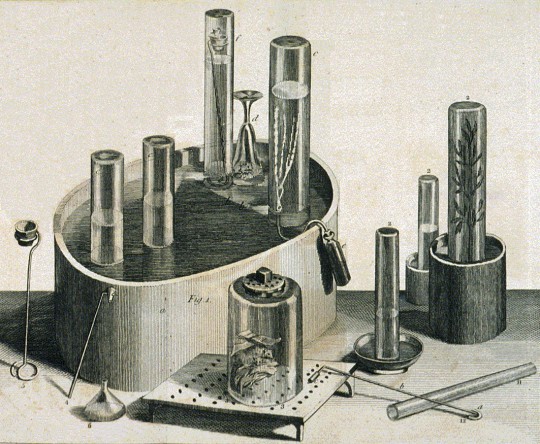
Equipment used by Priestley in his experiments on gases
Priestley's years in Calne were the only ones in his life dominated by scientific investigations; they were also the most scientifically fruitful. His experiments were almost entirely confined to "airs", and out of this work emerged his most important scientific texts: the six volumes of Experiments and Observations on Different Kinds of Air (1774–86). These experiments helped repudiate the last vestiges of the theory of four elements, which Priestley attempted to replace with his own variation of phlogiston theory. According to that 18th-century theory, the combustion or oxidation of a substance corresponded to the release of a material substance, phlogiston.
Priestley's work on "airs" is not easily classified. As historian of science Simon Schaffer writes, it "has been seen as a branch of physics, or chemistry, or natural philosophy, or some highly idiosyncratic version of Priestley's own invention". Furthermore, the volumes were both a scientific and a political enterprise for Priestley, in which he argues that science could destroy "undue and usurped authority" and that government has "reason to tremble even at an air pump or an electrical machine".
Volume I of Experiments and Observations on Different Kinds of Air outlined several discoveries: "nitrous air" (nitric oxide, NO); "vapor of spirit of salt", later called "acid air" or "marine acid air" (anhydrous hydrochloric acid, HCl); "alkaline air" (ammonia, NH3); "diminished" or "dephlogisticated nitrous air" (nitrous oxide, N2O); and, most famously, "dephlogisticated air" (oxygen, O2) as well as experimental findings that showed plants revitalised enclosed volumes of air, a discovery that would eventually lead to the discovery of photosynthesis. Priestley also developed a "nitrous air test" to determine the "goodness of air". Using a pneumatic trough, he would mix nitrous air with a test sample, over water or mercury, and measure the decrease in volume—the principle of eudiometry. After a small history of the study of airs, he explained his own experiments in an open and sincere style. As an early biographer writes, "whatever he knows or thinks he tells: doubts, perplexities, blunders are set down with the most refreshing candour." Priestley also described his cheap and easy-to-assemble experimental apparatus; his colleagues therefore believed that they could easily reproduce his experiments. Faced with inconsistent experimental results, Priestley employed phlogiston theory. This led him to conclude that there were only three types of "air": "fixed", "alkaline", and "acid". Priestley dismissed the burgeoning chemistry of his day. Instead, he focused on gases and "changes in their sensible properties", as had natural philosophers before him. He isolated carbon monoxide (CO), but apparently did not realise that it was a separate "air".
In August 1774 he isolated an "air" that appeared to be completely new, but he did not have an opportunity to pursue the matter because he was about to tour Europe with Shelburne. While in Paris, Priestley replicated the experiment for others, including French chemist Antoine Lavoisier. After returning to Britain in January 1775, he continued his experiments and discovered "vitriolic acid air" (sulphur dioxide, SO2).
In March he wrote to several people regarding the new "air" that he had discovered in August. One of these letters was read aloud to the Royal Society, and a paper outlining the discovery, titled "An Account of further Discoveries in Air", was published in the Society's journal Philosophical Transactions. Priestley called the new substance "dephlogisticated air", which he made in the famous experiment by focusing the sun's rays on a sample of mercuric oxide. He first tested it on mice, who surprised him by surviving quite a while entrapped with the air, and then on himself, writing that it was "five or six times better than common air for the purpose of respiration, inflammation, and, I believe, every other use of common atmospherical air". He had discovered oxygen gas (O2).
Priestley assembled his oxygen paper and several others into a second volume of Experiments and Observations on Air, published in 1776. He did not emphasise his discovery of "dephlogisticated air" (leaving it to Part III of the volume) but instead argued in the preface how important such discoveries were to rational religion. His paper narrated the discovery chronologically, relating the long delays between experiments and his initial puzzlements; thus, it is difficult to determine when exactly Priestley "discovered" oxygen. Such dating is significant as both Lavoisier and Swedish pharmacist Carl Wilhelm Scheele have strong claims to the discovery of oxygen as well, Scheele having been the first to isolate the gas (although he published after Priestley) and Lavoisier having been the first to describe it as purified "air itself entire without alteration" (that is, the first to explain oxygen without phlogiston theory).
In his paper "Observations on Respiration and the Use of the Blood", Priestley was the first to suggest a connection between blood and air, although he did so using phlogiston theory. In typical Priestley fashion, he prefaced the paper with a history of the study of respiration. A year later, clearly influenced by Priestley, Lavoisier was also discussing respiration at the Académie des sciences. Lavoisier's work began the long train of discovery that produced papers on oxygen respiration and culminated in the overthrow of phlogiston theory and the establishment of modern chemistry.
Around 1779 Priestley and Shelburne – soon to be the 1st Marquess of Landsdowne – had a rupture, the precise reasons for which remain unclear. Shelburne blamed Priestley's health, while Priestley claimed Shelburne had no further use for him. Some contemporaries speculated that Priestley's outspokenness had hurt Shelburne's political career. Schofield argues that the most likely reason was Shelburne's recent marriage to Louisa Fitzpatrick—apparently, she did not like the Priestleys. Although Priestley considered moving to America, he eventually accepted BirminghamNew Meeting's offer to be their minister.
Both Priestley and Shelburne's families upheld their Unitarian faith for generations. In December 2013, it was reported that Sir Christopher Bullock– a direct descendant of Shelburne's brother, Thomas Fitzmaurice (MP) – had married his wife, Lady Bullock, née Barbara May Lupton, at London's Unitarian Essex Church in 1917. Barbara Lupton was the second cousin of Olive Middleton, née Lupton, the great-grandmother of Catherine, Duchess of Cambridge. In 1914, Olive and Noel Middleton had married at Leeds' Mill Hill Chapel, which Priestley, as its minister, had once guided towards Unitarianism.
Many of the friends that Priestley made in Birmingham were members of the Lunar Society, a group of manufacturers, inventors, and natural philosophers who assembled monthly to discuss their work. The core of the group included men such as the manufacturer Matthew Boulton, the chemist and geologist James Keir, the inventor and engineer James Watt, and the botanist, chemist, and geologist William Withering. Priestley was asked to join this unique society and contributed much to the work of its members. As a result of this stimulating intellectual environment, he published several important scientific papers, including "Experiments relating to Phlogiston, and the seeming Conversion of Water into Air" (1783). The first part attempts to refute Lavoisier's challenges to his work on oxygen; the second part describes how steam is "converted" into air. After several variations of the experiment, with different substances as fuel and several different collecting apparatuses (which produced different results), he concluded that air could travel through more substances than previously surmised, a conclusion "contrary to all the known principles of hydrostatics". This discovery, along with his earlier work on what would later be recognised as gaseous diffusion, would eventually lead John Dalton and Thomas Graham to formulate the kinetic theory of gases.
In 1777, Antoine Lavoisier had written Mémoire sur la combustion en général, the first of what proved to be a series of attacks on phlogiston theory; it was against these attacks that Priestley responded in 1783. While Priestley accepted parts of Lavoisier's theory, he was unprepared to assent to the major revolutions Lavoisier proposed: the overthrow of phlogiston, a chemistry based conceptually on elements and compounds, and a new chemical nomenclature. Priestley's original experiments on "dephlogisticated air" (oxygen), combustion, and water provided Lavoisier with the data he needed to construct much of his system; yet Priestley never accepted Lavoisier's new theories and continued to defend phlogiston theory for the rest of his life. Lavoisier's system was based largely on the quantitative concept that mass is neither created nor destroyed in chemical reactions (i.e., the conservation of mass). By contrast, Priestley preferred to observe qualitative changes in heat, color, and particularly volume. His experiments tested "airs" for "their solubility in water, their power of supporting or extinguishing flame, whether they were respirable, how they behaved with acid and alkaline air, and with nitric oxide and inflammable air, and lastly how they were affected by the electric spark."
By 1789, when Lavoisier published his Traité Élémentaire de Chimie and founded the Annales de Chimie, the new chemistry had come into its own. Priestley published several more scientific papers in Birmingham, the majority attempting to refute Lavoisier. Priestley and other Lunar Society members argued that the new French system was too expensive, too difficult to test, and unnecessarily complex. Priestley in particular rejected its "establishment" aura. In the end, Lavoisier's view prevailed: his new chemistry introduced many of the principles on which modern chemistry is founded.
Priestley's refusal to accept Lavoisier's "new chemistry"—such as the conservation of mass—and his determination to adhere to a less satisfactory theory has perplexed many scholars. Schofield explains it thus: "Priestley was never a chemist; in a modern, and even a Lavoisierian, sense, he was never a scientist. He was a natural philosopher, concerned with the economy of nature and obsessed with an idea of unity, in theology and in nature." Historian of science John McEvoy largely agrees, writing that Priestley's view of nature as coextensive with God and thus infinite, which encouraged him to focus on facts over hypotheses and theories, prompted him to reject Lavoisier's system. McEvoy argues that "Priestley's isolated and lonely opposition to the oxygen theory was a measure of his passionate concern for the principles of intellectual freedom, epistemic equality and critical inquiry." Priestley himself claimed in the last volume of Experiments and Observations that his most valuable works were his theological ones because they were "superior [in] dignity and importance".
2 notes
·
View notes